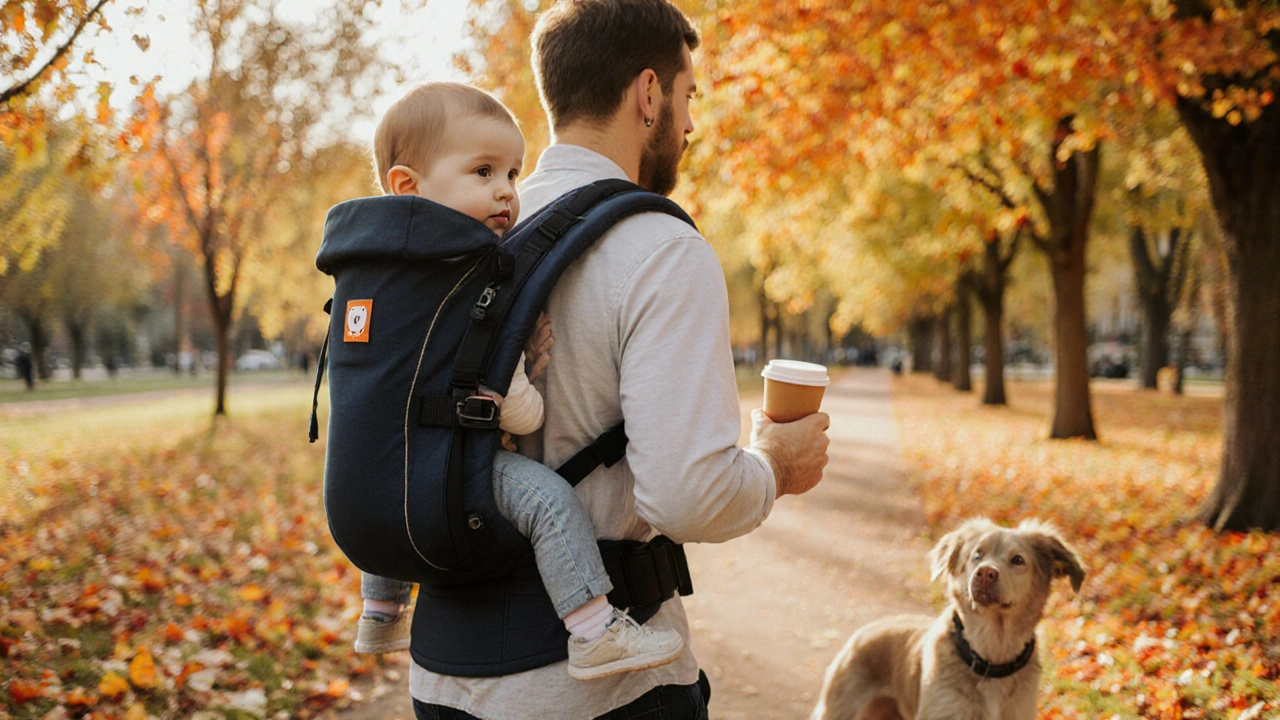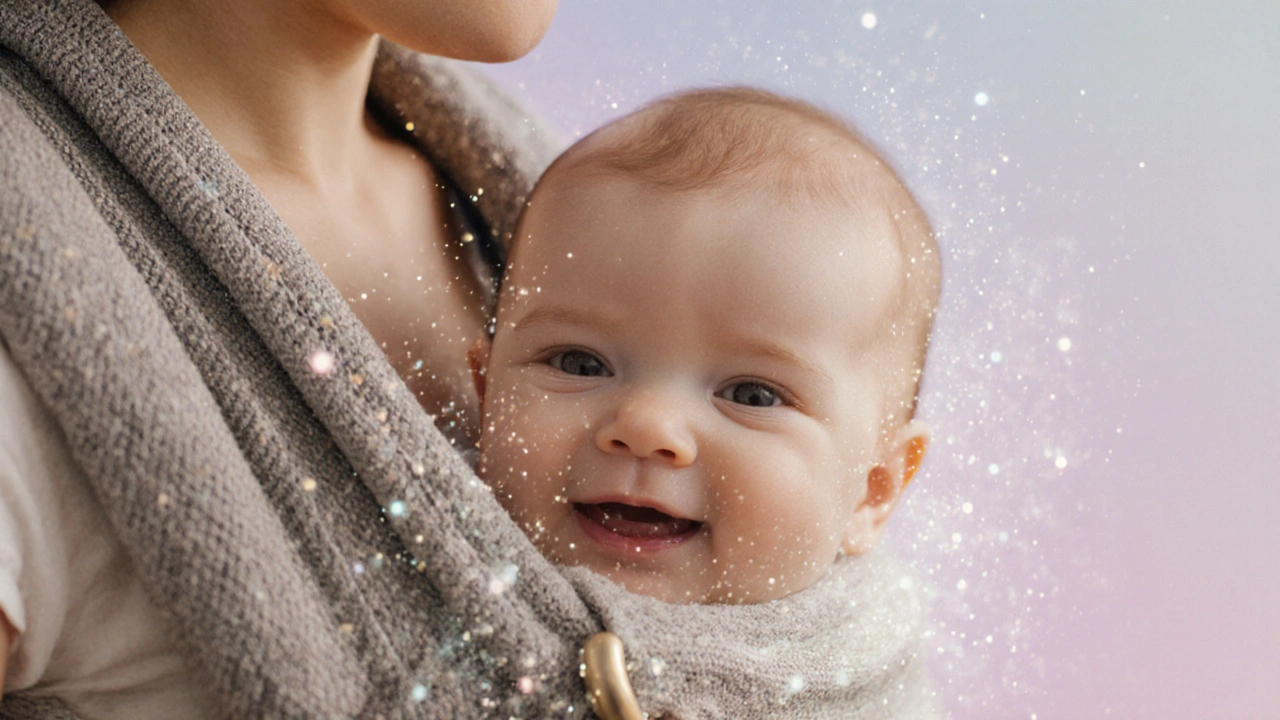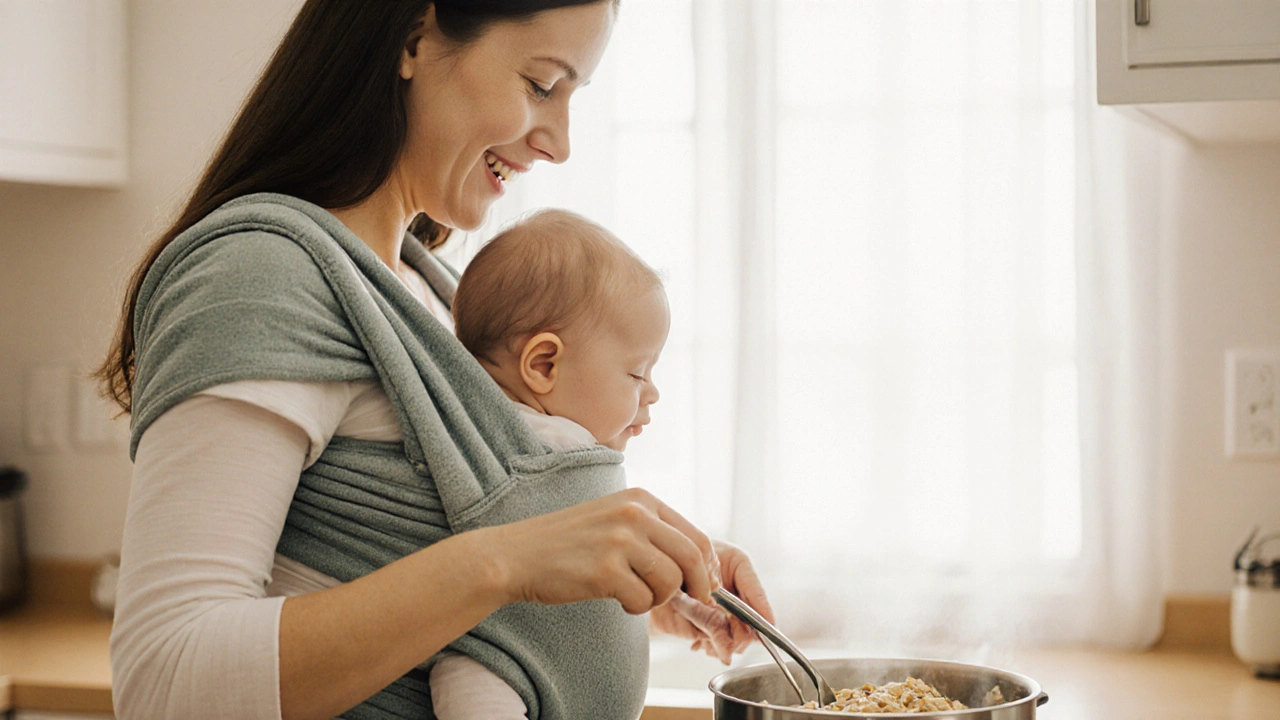Baby Carrier Selector
Select your preferences below to get a recommended carrier type.
Ever felt like you’re juggling a tiny human, a coffee cup, and a never‑ending to‑do list? Babywearing might just be the single habit that turns chaos into calm while strengthening the parent‑baby connection. Below we break down why strapping your newborn close matters, how to pick a safe carrier, and what to do when the first few days feel a bit bumpy.
Why Babywearing Deepens the Bond
When you wear your baby, two powerful hormones start a silent duet. Oxytocin is often called the "cuddle hormone" because it floods the brain during close physical contact, promoting trust and affection. At the same time, your infant releases cortisol in smaller, regulated amounts, which helps the baby stay calm under the gentle pressure of a carrier. The result? A calmer baby, a more relaxed parent, and a stronger emotional tie that research links to better sleep patterns and reduced crying.
The infant is most responsive to skin‑to‑skin contact during the first six months, a period critical for attachment formation. By keeping the baby’s chest against your body, you provide a constant source of warmth, heartbeat, and scent-three cues that signal safety and foster secure attachment, a foundation for healthy emotional development.
Convenience That Saves Time and Energy
Beyond the emotional perks, babywearing frees your hands for daily chores. Imagine walking the dog, loading groceries, or answering a work call while your newborn stays snugly in place. The hands‑free aspect also supports breastfeeding while wearing by allowing easy access to the breast without having to set the baby down on a surface. A survey of 1,200 new mothers showed that those who regularly used carriers reported a 30% reduction in perceived parental stress during the first three months.
Mobility isn’t just about getting stuff done; it also encourages gentle movement for the baby’s vestibular system. The subtle sway while you walk mimics the motions felt in the womb, helping with balance development and soothing colic symptoms.
Types of Carriers - Which One Fits Your Lifestyle?
Carriers come in four main families, each with its own strengths. Below is a quick side‑by‑side look so you can match a style to your routine.
| Carrier Type | Best For | Weight Range | Learning Curve | Typical Cost (USD) |
|---|---|---|---|---|
| Sling a single‑length piece of fabric worn over one shoulder | Quick trips, breastfeeding | Newborn‑15lb | Low - slip‑on | $30‑$80 |
| Wrap a long rectangle of fabric that you tie around yourself and the baby | Custom fit, newborn‑25lb | Broad - can adjust for growth | Medium - requires practice | $60‑$150 |
| Mei Tai a hybrid with a rectangular panel and detachable straps | Parents who want structure but flexibility | Newborn‑20lb | Medium - strap adjustments | $70‑$120 |
| Structured Carrier pre‑shaped, often with buckles and padded straps | On‑the‑go, older infants, outdoor activities | 6‑45lb | Low - zip‑in or buckles | $80‑$200 |

Safety First: Ergonomic Guidelines
Even though babywearing feels natural, a few rules keep both parent and child safe. The World Health Organization (WHO) recommends that carriers support the baby’s hips in an "M"‑position, where the thighs are spread and the knees higher than the buttocks. This posture reduces the risk of developmental dysplasia of the hip (DDH).
- Head support: For newborns, the carrier should cradle the head and neck. Look for carriers labeled “newborn‑ready” or add a soft insert.
- Hip alignment: The carrier’s leg holes should be wide enough for the baby’s legs to bend naturally.
- Weight limit: Never exceed the manufacturer’s weight rating. Most slings cap at 15lb, while structured carriers often go up to 45lb.
- Temperature checks: Keep an eye on both your and the baby’s temperature; a quick pat on the back or chest can prevent overheating.
- Breathing space: Make sure the baby’s chin is not pressed into the chest-there should be a clear gap for air.
When in doubt, perform the “sling test”: hold the carrier on your chest, place the baby inside, and try to fit your thumb between the baby’s chin and chest. If it fits, you’re good to go.
Choosing the Right Carrier for You
Selection isn’t one‑size‑fits‑all. Consider these three questions before you click “add to cart”:
- How often will you wear? Daily commuters benefit from structured carriers with quick‑release buckles, while occasional use may call for a simple sling.
- What climate do you live in? Breathable cotton or linen wraps work well in milder UK weather, whereas a fleece‑lined structured carrier keeps the baby warm on rainy Exeter days.
- Do you plan to breastfeed on the go? Look for carriers that offer front‑facing positions and easy access to the breast without removing the baby.
Once you’ve narrowed the field, try a “hands‑on” demo at a local baby store. Many shops let you test with a plush doll before you commit.
Troubleshooting Common Hiccups
Even seasoned parents hit snags. Here’s a quick fix guide for the most frequent issues:
- Skin irritation: Use a thin cotton liner between the baby’s skin and the fabric. Wash the carrier after each use to avoid buildup of sweat or saliva.
- Wrap slipping: Re‑tighten the knot or switch to a wrap with a “double‑knot” instruction. A small safety pin can hold the knot in place for the first few wears.
- Overheating: Remove extra layers from the baby, open any ventilation panels, and keep the carrier off direct sunlight.
- Difficulty positioning newborn: Use a newborn insert or a rolled‑up towel under the baby’s head for extra support.
Quick Checklist Before You Head Out
- Carrier is securely fastened and weight limit respected.
- Baby’s head, neck, and hips are properly supported.
- Both you and the baby feel comfortable; adjust straps as needed.
- Check temperature - the baby’s chest should feel warm, not sweaty.
- Have a diaper bag ready with a spare outfit and wipes.

Frequently Asked Questions
Can I babywear a newborn without an insert?
Most carriers labeled "newborn‑ready" provide built‑in head support, but adding a thin fleece insert adds extra cushioning. If the carrier’s fabric is too stiff, an insert is advisable.
Is babywearing safe for a baby with reflux?
Yes, as long as the baby is held upright at a 45‑degree angle. Many parents find that the gentle pressure of a carrier eases reflux symptoms compared to lying flat.
How long can I keep my baby in a carrier each day?
There’s no strict limit, but most experts suggest 2‑hour blocks followed by a break to let the baby’s hips and spine reset.
Do I need a different carrier for a baby who can sit up?
Once your child can sit upright unaided (usually around 6months), you can transition to a structured carrier that offers back support and higher weight capacity.
What fabric should I choose for the UK climate?
Cotton‑linen blends work well for the milder days, while a soft fleece or merino wool liner adds warmth during cold, rainy spells typical of Exeter.

All Comments
Kai Röder September 29, 2025
Babywearing can be a real game‑changer for families trying to juggle everything at once. By keeping the infant close you’re not only fostering oxytocin release, you’re also freeing both hands for chores, which studies show reduces perceived stress. Make sure the carrier you choose supports the hips in the “M” position to protect against DDH, and always double‑check head support for newborns. If you’re in a milder climate, a breathable cotton wrap works well; for cooler, rainy days a fleece‑lined structured carrier adds warmth without bulk. Feel free to test a few options in‑store with a doll before committing.
Brandi Thompson October 8, 2025
Honestly the whole babywearing hype feels like a marketing ploy that preys on exhausted parents who are desperate for any shortcut you know it’s sold as a miracle solution but when you strip away the glossy photos you see a lot of practical challenges that most articles gloss over the first thing many new parents forget is that not every carrier is created equal some cheap slings lack proper head support and can lead to dangerous positioning especially for newborns the lack of structured straps means the weight distribution can strain a parent’s shoulders quickly leading to aches and fatigue another overlooked issue is the temperature regulation a carrier that’s perfect for a mild day can become a sauna in a few minutes if you’re not vigilant the baby can overheat and that’s a real safety concern the article mentions the “sling test” but many parents misinterpret it thinking a thumb gap is a guarantee of safety when in reality you also need to assess hip alignment and ensure the thighs are spread the “M” position is not just a buzzword it’s a medical recommendation to prevent developmental dysplasia of the hip plus the breathing space under the chin is critical because a misplaced chin can restrict airflow and cause panic episodes the survey cited about reduced stress is interesting yet it doesn’t address the long‑term wearability for parents who have back problems or who are taller than average the straps on many structured carriers are not adjustable enough for taller bodies creating an uncomfortable incline on the baby’s spine the article’s checklist is helpful but it omits the importance of regular carrier cleaning to avoid skin irritation and odor buildup the reality is that babywearing is a tool not a cure you still need good sleep hygiene diaper changes and a solid support network for those late‑night feeds so take the hype with a grain of salt and do your own research before buying you’ll thank yourself later
Chip Hutchison October 17, 2025
One thing that often gets missed is how cultural practices shape our approach to babywearing. In many parts of the world, caregivers have been using wraps for generations, and they’re passed down as a shared family skill. If you’re new to it, don’t hesitate to ask a local parent group for a quick demo-they’ll gladly show you how to achieve that snug, hip‑healthy fit while keeping the baby’s head supported. Remember, the goal is comfort for both of you, so take a few minutes each day to adjust the straps and check the baby’s temperature. With a little patience, babywearing can become a natural extension of your daily routine.
Emily Moody October 26, 2025
When you strap that infant into a high‑performance ergonomic carrier, you’re essentially converting your torso into a kinetic nurturing hub, leveraging biomechanical leverage to off‑load torque from the lumbar region while simultaneously activating the infant’s vestibular circuitry. The thermoregulation matrix of a fleece‑lined structured carrier becomes a tactical asset in inclement climates, creating a microclimate that stabilizes core temperature. Think of it as a portable, anthropomorphic incubator-state of the art, yet deceptively simple to deploy. In short, it’s not just a piece of fabric; it’s a strategic parenting upgrade.
Prateek Kohli November 5, 2025
Absolutely love how babywearing can turn a hectic morning into a smooth dance 💃🏽. Just make sure the carrier’s hip slot is wide enough for that natural “M” position, and you’ll keep those tiny hips happy. If it’s chilly outside, slip a soft liner under the baby for extra warmth without overheating. Quick tip: check the baby’s chest temperature with the back of your hand; it should feel warm, not sweaty 😊.
Noah Seidman November 14, 2025
We must not ignore the ethical dimension of babywearing; it’s a responsibility to ensure every child receives the physiological benefits of close contact, not just a trendy accessory for Instagram. When parents prioritize convenience over safety, they risk compromising hip development and breathing space, which is morally indefensible. The industry should enforce stricter standards on head and hip support, and caregivers ought to be educated on proper ergonomics before purchase. Anything less is an abdication of our duty to protect the most vulnerable members of society.
Anastasia Petryankina November 23, 2025
Oh, because spending $150 on a carrier is clearly the pinnacle of parenting wisdom, right? As if the baby’s natural instinct for skin‑to‑skin could ever be replaced by a designer fabric. Sure, let’s all line up for the latest “must‑have” and pretend we’ve solved the whole attachment thing with a buckled strap. Meanwhile the baby just wants to be held, not accessorized.
Sarah DeMaranville December 2, 2025
Carriers are cool but don’t forget the diaper changes.
Edward Leger December 12, 2025
In contemplating the act of carrying an infant, one observes a microcosm of human interconnectedness, where the boundary between self and other blurs. The gentle rhythm of a parent's heartbeat becomes a metronome for the child's emerging sense of security, a subtle reminder that our bodies are vessels of both protection and dependence. Such moments, fleeting as they are, echo philosophical inquiries into the nature of care and the ethics of nurturing.
Louie Hadley December 21, 2025
For anyone weighing daily commuter life against occasional outings, the structured carrier shines with its quick‑release buckles and solid support. Yet if you’re only wearing it a few times a week, a sling or wrap can provide that same closeness with less bulk. The key is matching the carrier’s ergonomics to your routine, climate, and feeding style, then giving it a test run with a plush doll to feel the fit before buying.